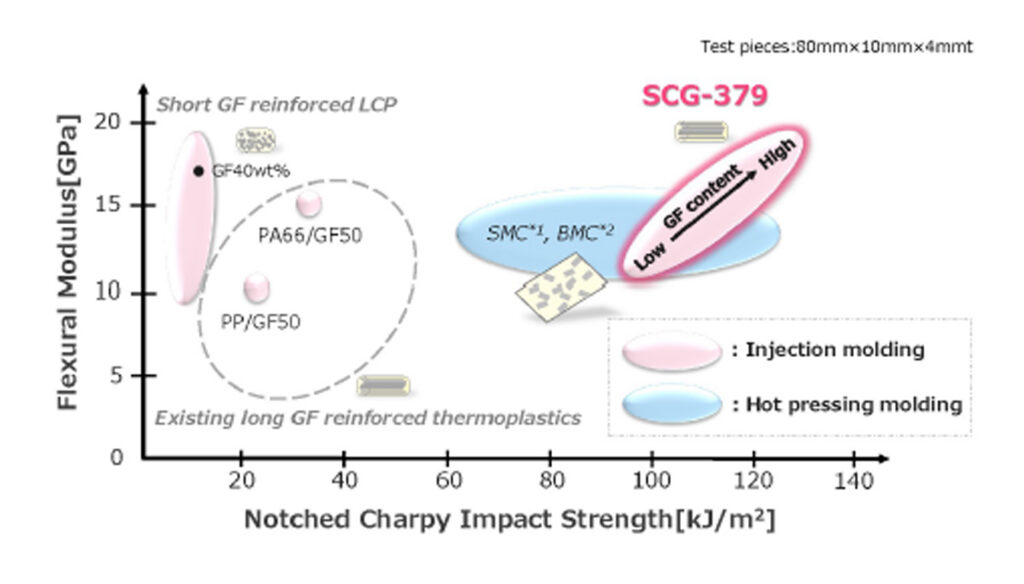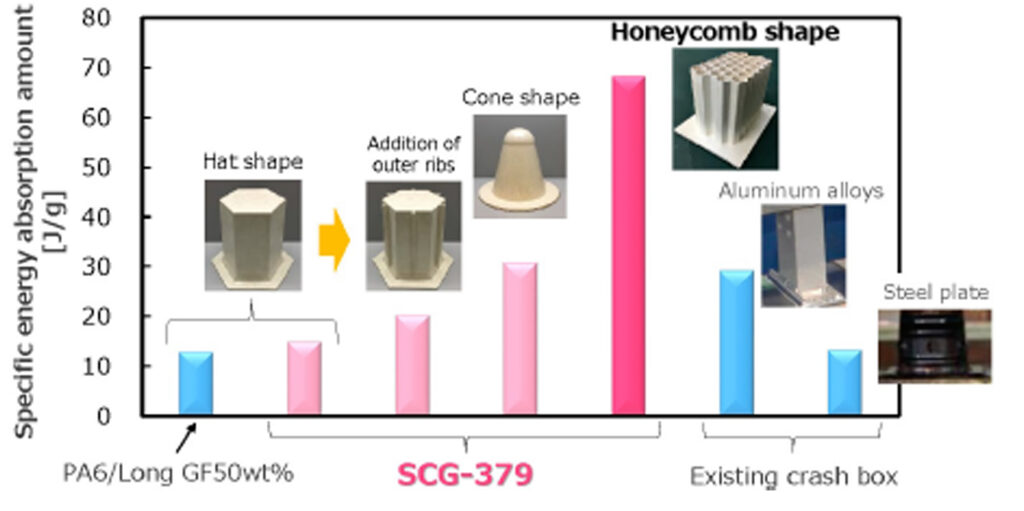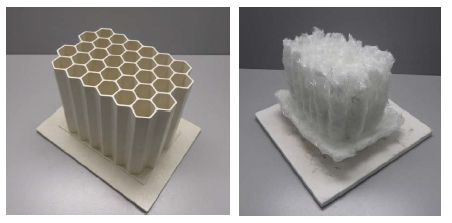Sumitomo Chemical to Introduce New Long-Fiber Thermoplastic Liquid Crystal Polymers
First commercial products to feature carbon, glass fiber reinforcement, targeted to replace aluminum, magnesium, steel alloys
FOR IMMEDIATE RELEASE: 21 July 2022
PR # SCAT-01-22
Contact: phone: +1.602.659.2508, [email protected]
Phoenix, Ariz., U.S. — Sumitomo Chemical Advanced Technologies (here) has developed and will soon commercialize a new family of long-fiber thermoplastic (LFT) compounds with high-performance liquid crystal polymer (LCP) matrices reinforced with 13-mm chopped carbon fiber or fiberglass. The new materials are currently undergoing customer evaluations in several industries and developmental quantities of two grades — SUMIKASUPER™ SCG-379 with 30-50% fiber-weight fraction (FWF) E-glass and SUMIKASUPER SCG-420 with 30-40% FWF high-modulus carbon fiber — are available to interested parties for testing. An LCP matrix and the option for carbon fiber reinforcement will significantly upgrade the thermal and mechanical performance available from LFT technology and the products are being targeted to replace alloys of aluminum and magnesium as well as steel.
Pelletized LFT compounds were originally developed in the 1990s to increase the mechanical performance of short-fiber injection moldable thermoplastics in the automotive industry for a variety of semi-structural interior and exterior panels. Given these automotive roots, the vast majority of all commercial LFT products feature fiberglass-reinforced polypropylene (PP), although higher temperature polyamide 6 and 6/6 (PA6, PA6/6) have been gaining marketshare in this segment. Beyond automotive, which still consumes the majority of LFT materials, the products have expanded into applications in the sporting goods, power tool, and appliance industries. And commercial carbon fiber-reinforced LFT grades are available in PP, PA, thermoplastic polyurethane (TPU), polyphenylene sulfide (PPS), polyetheretherketone (PEEK), and polyethersulfone (PES).
LCPs are a family of polymers that produce thermoplastic parts with unique processing characteristics and extremely high performance — including the highest thermal stability of any thermoplastic — which is why they are commonly used to replace metals, ceramics, and polymer composites. Most commercial LCPs are aromatic polyesters characterized by high thermal and mechanical performance, excellent and inherent flame/smoke/toxicity (FST), good weatherability, excellent electrical insulation1, high resistance to stress cracking, and chemical inertness.2 This makes them ideal for use in electrical and electronic components (including fiberoptic cables, printed circuit boards, chip carriers, connectors (conventional, radio-frequency (RF), and fiber-optic), and other surface-mount components), microelectromechanical systems (MEMS), automotive applications (including components for ignition and transmission systems, lamp sockets, pump components, coil forms, and sensors), printer/copier/fax components, cookware, high-barrier/retort-processed food containers, plus components for chemical processing (including pumps, meters, and valves). Recently, Sumitomo Chemical introduced the industry’s first chemically soluble LCPs, which were specifically developed to produce films and coatings to protect flexible and rigid electronic components and speaker membranes.
Commonly processed by injection molding — although the new LFT compounds also can be compression molded — LCPs also can be melt-spun into fiber, extruded or cast into thin sheets/films, and applied as coatings. Molded parts can be joined via thermoplastic welding techniques, especially ultrasonic and laser welding. Plating and adhesive bonding to LCPs are possible when a special additive package is used. Owing to the highly rigid structure of their molecular chains, the weak van der Waals forces between molecular chains, and their liquid crystalline nature — which tend to be nearly linear and to occupy a stacked orientation that maintains its order regardless of solid or liquid phase — LCP polymer chains easily align in the flow direction during molding and are highly anisotropic. This not only accounts for their excellent flow-direction mechanical properties, which results from the self-reinforcing orientation, but also for the high flow and molding productivity that characterize these materials, which cycle as fast as 5-10 seconds at low injection pressures.
Most thermoplastics and especially fiber-reinforced thermoplastics exhibit some anisotropy after processing. However, molded properties of LCPs can vary significantly between flow and cross-flow directions3. Hence, care should be used when designing parts and molds for LCPs to take advantage of (and avoid the challenges of) this characteristic. High anisotropy means weldlines (where flow fronts with different molecular orientations converge) are weaker and prone to warpage and thermal-expansion differentials. Hence, LCPs are typically reinforced with glass fiber and mineral fillers — not so much to increase stiffness and strength but to reduce anisotropy. Warpage also can be reduced with proper gate design in the mold. Because of their high performance, LCPs are priced accordingly as a premium product. However, given their high melt flow rates, fast setup times, and low thermal expansion in the direction of flow, LCPs can be formed into thin-wall parts with short molding cycles that deliver high performance at low mass and lower material usage — all of which help offset higher initial material costs. The thermal stability typical of LCPs enables processors to efficiently reuse regrind and recycle reject parts, which again reduces material losses and lowers effective part cost.
The new LFT-LCPs grades have been under development for four years. The most challenging issue to overcome was finding the right fibers to maximize performance of the LCP compounds.
“It has long been established that mechanical properties of plastics increase with longer fiber lengths,” explains Takayuki Sugiyama, Sumitomo product manager. “However, it also is well known that rarely do fibers longer than 2 mm survive the screw, runners, and gates to make it into the mold and the molded part during the injection molding process. Therefore, the advantage of starting with significantly longer fiber reinforcement in LFT materials is not being fully realized.”
“Given the ease of processing LCP materials, we felt we could take advantage of their low melt viscosity and low molding pressures to better preserve fiber length during injection molding,” adds Tomohiro Sato, Sumitomo senior manager. “It is important to note that these materials are being positioned against lightweight metallic alloys and even steel where they offer comparable or higher mechanical performance at much lower weight, better energy management, elimination of corrosion, reduced manufacturing and finishing steps, and very-fast processing times, which will help offset initial higher material costs.”
One especially promising area of research with the new compounds has been molding them into a variety of energy-management structures and then conducting crush tests to see how much energy they absorb before failure. Test results on structures ranging from ribbed hat and cone designs to a variety of honeycombs show the LFT-LCP grades offer excellent energy absorption, exhibit very-controlled crush characteristics, and produce no sharp shards during ductile failure. This suggests the materials may be good candidates for crash structures (e.g., bumper crash boxes and rocker and pillar reinforcements) on passenger vehicles. Owing to their high thermal and broad chemical stability, LCP parts can be mounted to the body-in-white (BIW) during initial vehicle build and travel through the electrophoretic coating (e-coat) lines where rust-prevention coatings are applied to vehicle structures. Although LCPs do not corrode, the ability to survive e-coat makes it easier to use such materials in chassis structures, since their use does not require changing the way vehicles are assembled. Other automotive uses could include rails and support structures on sunroof systems and seating components. Outside the automotive industry, high-end sporting goods and industrial uses such as end of arm tooling for robots are also being explored.
Although no firm date has been set for commercializing the products, researchers say they are busy working with industry partners to collect technical data and build case studies that demonstrate how well the LFT-LCP compounds solve existing industry challenges.
Sumitomo Chemical Advanced Technologies LLC — formerly called Sumika Electronic Materials and a wholly owned subsidiary of Sumitomo Chemical Co., Ltd. — is a leading manufacturer of liquid crystal polymer (LCP), polyethersulfone (PES), and high-performance alloy resins. The company serves as the U.S. base of operations and customer support for Sumitomo Chemical’s photoresist and engineering plastics businesses and is certified to ISO9001:2015* and ISO14001:2015* standards. For more information, see https://sumichem-at.com/our-business/super-engineering-resins/ or call +1.602.659.2508 or email [email protected].
1 Electrical properties include high electrical resistivity, low relative dielectric constant, and low dissipation factor.
2 Resistance is excellent to strong and weak acids, alcohols, esters, ketones, and aromatic, chlorinated, and halogenated hydrocarbons over a broad range of temperatures. Hydrolytic stability in boiling water also is excellent. LCPs can be attacked by high-temperature steam, concentrated sulfuric acid, and boiling caustic chemicals. A more comprehensive treatment of the chemical resistance of LCPs is shown in Table 1 at https://www.sumitomo-chem.co.jp/sep/english/products/lcp/lcp_bs_kagaku.html.
3 It has been reported in the literature that anisotropic-dependent properties (e.g. tensile strength, coefficient of linear thermal expansion (CLTE), and elastic modulus) can be up to 3x greater in the flow vs. cross-flow direction. LCPs also have a high Z-axis CLTE.

FOR IMMEDIATE RELEASE: 21 July 2022
PR # SCAT-01a-22
Contact: phone: +1.602.659.2508, [email protected]
Phoenix, Ariz., U.S. — Sumitomo Chemical Advanced Technologies has developed and will soon commercialize a new family of long-fiber thermoplastic (LFT) compounds with high-performance liquid crystal polymer (LCP) matrices reinforced with 13-mm chopped carbon fiber or fiberglass. An LCP matrix and the option for carbon fiber reinforcement will significantly upgrade the thermal and mechanical performance available from LFT technology. The graph above plots flexural modulus against notched Charpy impact strength for a variety of short-fiber and long-fiber thermoplastics, as well as thermoset sheet molding compound (SMC) and bulk molding compound (BMC), plus SUMIKASUPER™ SCG-379 with E-glass reinforcement.

FOR IMMEDIATE RELEASE: 21 July 2022
PR # SCAT-01b-22
Contact: phone: +1.602.659.2508, [email protected]
Phoenix, Ariz., U.S. — Promising work by Sumitomo Chemical researchers that evaluated the energy-management capabilities of the new SUMIKASUPER™ LFT-LCP compounds indicates they offer excellent energy absorption, exhibit very-controlled crush characteristics, and produce no sharp shards during ductile failure. These attributes may open opportunities for the compounds to be used in a variety of automotive crash structures on bumpers, in rockers, and inside pillars — particularly since LCPs can survive the thermal and chemical demands of electrophoretic coating (e-coat) rust-prevention lines.
Attention Editors: Medium-resolution digital artwork available upon request.

FOR IMMEDIATE RELEASE: 21 July 2022
PR # SCAT-01c-22
Contact: phone: +1.602.659.2508, [email protected]
Phoenix, Ariz., U.S. — Owing to the ease of processing LCP in general, Sumitomo Chemical researchers have molded the new SUMIKASUPER™ LFT-LCP grades into complex energy-absorbing structures like the tall honeycomb shown on the left above. Burnout tests (right) have demonstrated the high amount of fiber (in this case glass) penetration achieved during injection molding of the complex tubular structures. This feature contributes not only to the excellent mechanical performance shown by the new compounds but also their ability to absorb significant energy and fail in a ductile manner, which makes the materials of interest to automakers, sporting-goods producers, and for industrial applications like end-of-arm tooling for robots.
Attention Editors: High-resolution digital artwork available upon request.
™ SumikaSuper is a trademark of Sumitomo Chemical Co., Ltd.
* ISO is a registered trademark of the International Organization for Standardization.
